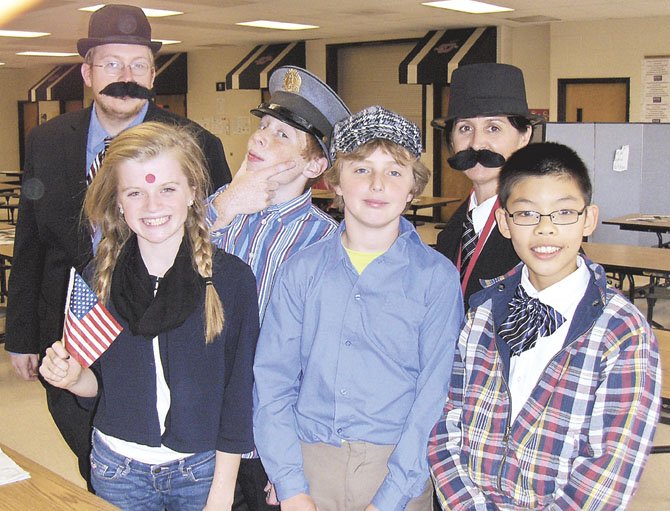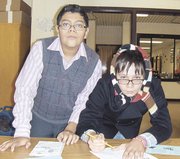Back row, from left, are history teacher Dan Vroman, “Scottish policeman” Ryan Morris and history teacher Jeanne Costello; (front row, from left) are “Greek immigrants” Annie Davis, Jared Brennan and Shaun Wu. Photo by Bonnie Hobbs.
Centreville — Sitting on the floor, jammed together in a narrow locker area, the Rocky Run seventh-graders pretended they were immigrants packed into a boat from Europe to America. They watched a video of the approach to New York Harbor while listening to Neil Diamond sing, “Coming to America.”
Then the Statue of Liberty came to life before them, guiding their way to Ellis Island, where they found signs listing their countries of origin and waited for their names to be called. Participating in this recent exercise were all 20 seventh-grade classes and their teachers, Jamie Sawatsky, Dan Vroman, Maggie Brown, Susan Rowland and Jeanne Costello.
It was hands-on learning to give students a better idea of the immigrant experience. Before going on their journey, they each received personas, including their country, occupation and family details. Then their photos were taken for passports.
While on board ship, teachers told them what the conditions were like there for the immigrants — the heat, bad food, nausea and diseases. But as Staten Island came into view, the students/immigrants became excited to start their new lives in the U.S.
“At Ellis Island, 500 students go through literacy and medical stations,” said Sawatsky. “Then they have to answer questions about themselves — where they’re from and why they’re coming to America. Some are alone and others travel in groups. Some of the kids really get into it and dress up.”
Student Annie Norris portrayed a mentally insane Italian immigrant. “I held sock puppets and talked to them,” she said. “I said they were my best friends, Paco and Julian. I also got thrown in jail, but broke out. It was fun — people gave me some weird looks.”
Annie learned “how hard it was to get to America and how many different types of people came here. It was cool to feel like a person going back in time and really experiencing it.”
Shreyas Angara was an 8-year-old Polish boy named Adolph Lowski, traveling with his parents and brother, 10. They journeyed to the U.S. for a new life and better jobs. “They wanted to get land in the Homestead Act and start farming,” said Shreyas. “And Adolph was looking forward to having an adventure.”
“I learned it wasn’t easy to get into America,” he continued. “You had to go through many tests. If we’d just learned about this by textbook and reading notes, we wouldn’t have realized how important it was. But after we went through Ellis Island, we learned how the immigrants there actually felt.”
Playing a Greek girl, 15, traveling with her sister and brother, was Nihal Guennouni. “We were looking for jobs to earn some money, but I didn’t make it past the passport checkpoint because I had a fake passport. They also asked how much money you had, if you were married or single and if you were ever in jail. She said a doctor also examined the immigrants to see if they were strong and healthy enough to live in America.
“It was fun because, when we were on the boat immigrating, the teachers sprayed us with water from squirt bottles to simulate the waves,” said Nihal. “And we were really crowded and uncomfortable, but that’s how it was on the ships. I learned that they were strict about the immigrants they let in and they yelled at them the whole time. It would have been really tough.”
Besides that, she said, “You had to wait a long time at Ellis Island and answer lots of questions. And some people were confused because you had to read and follow directions about what to do, in English — which would have been hard for the immigrants because it wasn’t their primary language.” Nihal’s usually bored reading textbooks. But, she said, “When you’re doing hands-on learning, it’s more interesting and intriguing and stays in your mind longer.”
Matthew Rodriguez portrayed a Russian man, 20, looking for work. “He had an eye disease, but made it through,” said Matthew. “I liked going through all the stations because it was like real life. I learned that it took forever and they were quarantined and asked all these questions. It helps you learn what it was like, and it was fun because we got to do stuff and act it out.”
Meanwhile, Gabrielle Kelly was an 87-year-old German woman trying to join relatives in the U.S. “I didn’t have the proper paperwork, so I was going to bribe an inspector to get into America,” she said. “But instead, I married a 74-year-old man and we entered together. I learned it was easier for a woman to come to America if she had a man to watch over her.”
History teacher Jeanne Costello played an immigration official. “I asked what occupation they’d have in America and if they had any special skills,” she said. “I also needed their destination address.”
Ryan Morris portrayed a police officer, 25, who’d left Scotland for better pay in the U.S. Toughest, he said, was learning all the different rules in a new country. “Some people were rejected because they had certain issues, mostly medical,” he said. “This was a good activity because, when you participate in something, it makes it more fun and interesting.”
Playing an Austrian man, 21, was Cole Grinnell. “I wished to be a stockbroker in America,” he said. “But I had mental problems and was jailed for being a detriment to society, but I was later released. It’s a fun thing to do because you get to pretend to be other people. And it’s neat to get an idea of what they went through when they came to America.”
Emigrating from Greece with his 15-year-old twin brother was Jonathan Morales. “This is kind of strange,” he said. “I’ve never had so many people scream at me. And the boat voyage was hard — 23 long nights sleeping on a bunk bed. But it’s really interesting knowing about the history of America. We’ll always remember the day we did this.”

